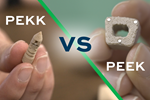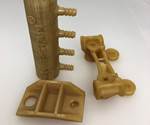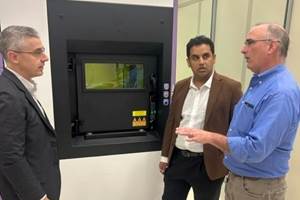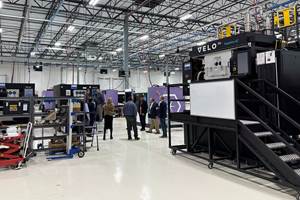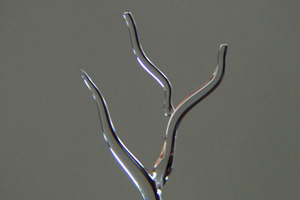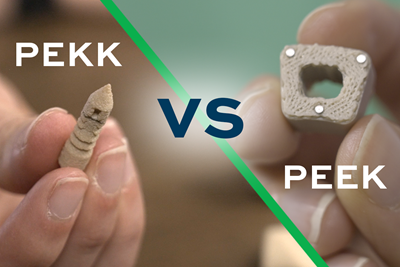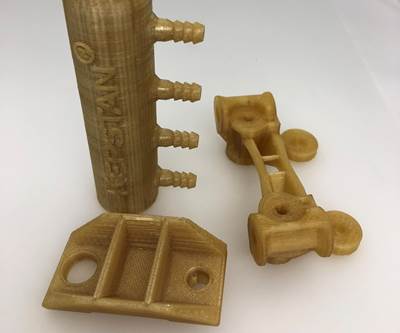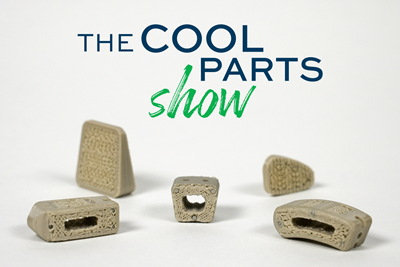Scroll to unlock this premium content if video does not play.
[Corrections to a few of the numbers in this video: To date, around 50 surgeons have used Curiteva’s Inspire implants. More than 2,000 of the devices have been implanted into around 1,000 patients, with some of them receiving two or more implants.]
In episode #63 of The Cool Parts Show, we learned how medical device manufacturer Curiteva is applying a proprietary 3D printing process to produce spine implants from PEEK. Polyether ether ketone offers mechanical properties similar to bone, making it attractive for this application, and machined and molded PEEK implants have been in use for years. But Curiteva’s process, Fused Strand Deposition (FSD), brings new geometric possibilities, including porosity that enables better osseointegration. Since our previous episode on the company’s cervical spine implants, Curiteva has achieved FDA clearance for a second product line of lower lumbar implants. In this bonus video, we visit its Huntsville, Alabama, facility to learn how the manufacturer is now scaling up production of these implants through FSD. | This bonus episode of The Cool Parts Show is sponsored by Carpenter Additive
The Cool Parts Show is a video series from Additive Manufacturing Media that explores the what, how and why of unusual 3D printed parts. Watch more here.
Have a cool part to share? Email us.
Related Resources
- Episode #63 on Curiteva’s cervical spine implants, its first 3D printed PEEK product line
- Understanding PEEK and a similar material, PEKK, for 3D printing
- Another episode on a medical implant made from polymer (in this case, PEKK applied with selective laser sintering)
- How to think about 3D printing with high-performance polymers like PEEK
Transcript
I'm Pete.
I'm Stephanie.
Welcome to a bonus episode of The Cool Parts Show.
This is a follow-up to episode 63, where we looked at 3D-printed cervical spine implants made by Curiteva, made from PEEK, a polymer.
PEEK. PolyEtherEtherKetone.
Great material for making spine implants because it has material properties that are very close to the properties of the bone that it implants alongside, but it's a difficult material to manufacture with. It is difficult specifically to 3D print, and that means it's hard to get a porous PEEK implant, a PEEK implant that the bone can grow into.
Osseointegration was largely out of the question until Curiteva figured out a way to 3D print effectively with PEEK. To 3D print the kind of elaborate forms with all these open spaces that bone can grow into. Their process is called fused strand deposition. And the original episode we did with Curiteva involved the very first spine implant to be 3D printed that way that was cleared by the FDA.
That's right. In that previous episode, we looked at this cervical spine implant and talked about the long and arduous process that it went through to achieve that FDA clearance. It took 18 months to establish that this design, this process, this material, was going to result in medical devices that were suitable for use. But Curiteva recently had a second product line cleared by the FDA, and we have some examples of that here.
So these are implants for the lower lumbar. So a different area of the spine. That's one difference. But they're also made in a much greater variety of shapes and sizes. So for reference, the cervical spine line, there's about 30 different parts, different sizes, different configurations of those implants in that product line. For lower lumbar, Curiteva has created something like 1300 different SKUs. So there's a much greater variety.
But another big difference with these implants is that they got through that FDA clearance process much more quickly. So it was not an 18-month process. It was just 57 days. So this is the success that Curiteva is having. More spine implants are being approved. They're being approved faster because that first implant, it kind of paved the way. They're being adopted. More than 500 surgeons have used these implants. More than 1100 of these implants have gone into patients and helped them.
All of this has led to pretty significant manufacturing demand for Curiteva. So we traveled to their factory in Huntsville, Alabama, to see how these 3D-printed PEEK implants are produced.
That's right. And we saw a lot of things there. So this is the facility where they're making these 3D-printed spine implants, but they also produce other types of medical devices there. And they're using a multitude of different technologies. So we saw five-axis milling, we saw turning, wire EDM, but of course, we were most excited to see the 3D printers and all of the additive machines that Curiteva uses. There are 3D printers that they have built and developed themselves. They're all grouped together in this clean room environment, and right now they have nine 3D printers that are qualified to be making these spine implants. And there's a 10th machine that's not qualified but that's used for R&D efforts.
Huge thanks to Chief Operating Officer Bill Voss. He was our host, spent time with us, showed us around the facility. A couple things we saw there, themes that we talk about a lot in our reporting on additivemanufacturing.media. One of them is a concept we've come to call the “AM Factory”. This is where the developer, inventor of a proprietary 3D printing process leverages that process for their own use. There are many examples of this, and Curiteva is just the latest example that we've encountered. Curiteva makes fused strand deposition 3D printers, but it does not make them to sell to other companies. It makes them to use within their special manufacturing facility devoted to making these special 3D printed implants.
Another big theme, even more fundamental additive manufacturing is more than 3D printing. 3D printing is at the heart of it, at the start of it, but there is a whole sequence of operations necessary to realize additive manufactured inserts like this. And at the Huntsville facility, in that clean room, we saw just about all the steps. Not every single step, but a very vertically integrated production line, within this one facility for manufacturing these implants and we got to walk through that process.
Yeah. So I'll try to summarize it here. So it all starts with the material. Curiteva is using PEEK filament provided by Evonik. The filament gets dried, loaded into the printers, and then applied to make one of a variety of different spine implant designs. After printing, the implants are removed from the build plate, the supports are removed, and then they get cleaned with IPA (isopropyl alcohol). From there, all of the implants go through an annealing process for stress relief, and then they go on to machining to drill holes or add any additional features that might be necessary. They get cleaned again, and then they go into assembly. As we talked about in our previous episode, PEEK is radiolucent. It does not appear on an X-ray. So in order to allow the surgeons to keep track of where the implant is and to monitor the patient healing, Curiteva inserts these little titanium locator pins in all of their implants to allow for that. So that's part of the assembly process. They're also working on some other designs where there could be additional pieces of metal or other things added to implants after the fact.
After assembly, they get cleaned again, and then they go through laser marking. And up to this point, all of the steps that I have described are taking place in that clean room that we saw there at Curiteva. They have not left up until this point, but after laser marking, the implants do go to an outside supplier. They get a coating of hydroxyapatite. That is what makes the material hydrophilic and encourages bone to grow into these implants later. They come back after that coating process for sterile packaging, and then they go into inventory at Curiteva where they wait for the moment that they're needed.
So here's how that process runs week by week. Two shifts a day, ten hours per shift, five days per week. Couple interesting points. This one actually came out in our previous episode, which is the 3D printing cycle at Curiteva produces just one implant at a time. They do it that way for process control. It doesn't take long. A 3D printing cycle for any of these implants is about 30 to 45 minutes. Machining comes a little later. Machining isn't one implant at a time. The similar implants can be batched for machining altogether and not much machining is needed. There is fine drilling for those locator pins, and there is some milling of surfaces that are useful for gripping the implant during surgery.
One really striking point came out when we were learning about all this, which is the low amount of waste that is part of this process. Only 2% of the material is lost in the manufacture of these implants. 98% of the material ends up in the implant itself. Conventional manufacturing of PEEK implants doesn't look like that. It's much more machining, much more of like a hog out machining process to get the geometry. We saw that happening at Curiteva too. There's an entire machining area. And part of the work they were doing is manufacturing conventional PEEK implants. But this process with only 2% waste, that material control is a big part of the cost-effective fineness of this product. Because this PEEK, the PEEK material, it is high-value material. It is not inexpensive.
So Curiteva is putting this low-waste manufacturing process to use now. They've got these two product lines, the cervical spine, the lower lumbar spine, and they’re ramping into production on both counts. So when we were there, there were those nine 3D printers producing these implants, but they're getting ready to put 20 additional production printers into that same clean room environment because of the demand that they expect to be serving soon.
Thank you, Curiteva, for hosting us in your Huntsville production facility. For letting us share this look at 3D printed PEEK implant production.
If you want to learn more about Fused Strand Deposition, Curiteva's process and see what that looks like. 3D printing that is a lot like pulling strands of taffy. We get into it in more detail in our original episode about Curiteva. We will put a link in the show description. And if you're interested in learning more about PEEK and some of the intricacies of printing with this material, we have a video about that as well, which we'll also link in the show notes.
Thanks for watching.
Related Content
New Zeda Additive Manufacturing Factory in Ohio Will Serve Medical, Military and Aerospace Production
Site providing laser powder bed fusion as well as machining and other postprocessing will open in late 2023, and will employ over 100. Chief technology officer Greg Morris sees economic and personnel advantages of serving different markets from a single AM facility.
Read MoreZeda AM Production Plant in Ohio Now Open — Thoughts on the New Facility
73,000-square-foot metal powder bed fusion plant includes extensive machining capability plus separate operational models for serving medical versus other businesses.
Read MoreIce 3D Printing of Sacrificial Structures as Small as Blood Vessels
Using water for sacrificial tooling, Carnegie Mellon researchers have created a microscale method for 3D printing intricate structures small enough to create vasculature in artificial tissue. The biomedical research potentially has implications for other microscale and microfluidics applications.
Read MoreCranial Implant 3D Printed From Hydroxyapatite Ceramic: The Cool Parts Show #76
Cranial implants are typically made from titanium or PEEK; in this episode of The Cool Parts Show, we look at how implants made from a bioceramic can improve osseointegration and healing.
Read MoreRead Next
Understanding PEKK and PEEK for 3D Printing: The Cool Parts Show Bonus
Both materials offer properties desirable for medical implants, among other applications. In this bonus episode, hear more from Oxford Performance Materials and Curiteva about how these companies are applying PEKK and PEEK, respectively.
Read MoreUltem, PEEK or PEKK? Choosing Between High-Temperature Plastics
How do you choose between these high-performance materials? A conversation with Arkema and Plural AM sheds light on 3D printing with these polymers.
Read MoreFDA-Approved Spine Implant Made with PEEK: The Cool Parts Show #63
Curiteva now manufactures these cervical spine implants using an unusual 3D printing method: fused strand deposition. Learn how the process works and why it’s a good pairing with PEEK in this episode of The Cool Parts Show.
Read More

.jpg;width=70;height=70;mode=crop)
